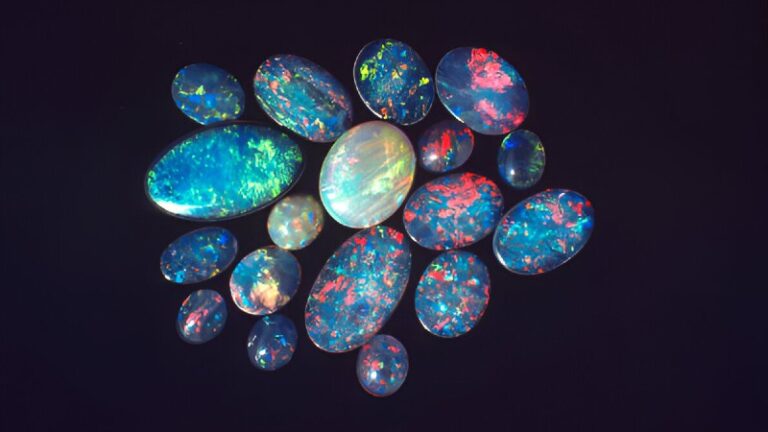Opals have fascinated humanity for centuries with their vibrant, shifting colors and mysterious origins. Known as the gemstone of light, opals are unlike any other mineral, captivating jewelers, collectors, and scientists alike.
What Makes Opals So Unique?
Unlike traditional gemstones that owe their color to chemical impurities, opals display their kaleidoscopic play-of-color through a rare microstructure. This phenomenon is called opalescence.
The Science Behind Opal’s Play-of-Color
Opals are composed of tiny, uniform silica spheres stacked in a three-dimensional grid, with water filling the gaps. When light hits these spheres, it bends (diffracts) and splits into the spectrum of colors — much like a prism. The size of the silica spheres determines which colors dominate:
- Smaller spheres (~0.1 microns) produce blues and greens
- Larger spheres (~0.2 microns) produce reds and oranges
- Intermediate sizes create other spectral colors
This microscopic structure is unique to precious opal and distinguishes it from common opal, which lacks play-of-color.
Opal Types and Their Characteristics
Opals are classified based on their body tone and transparency. Here’s a concise overview:
| Opal Type | Body Tone | Transparency | Notable Features | Example Location |
|---|---|---|---|---|
| White (Light) Opal | Light | Translucent to semi-translucent | Delicate play-of-color on white background | Coober Pedy, Australia |
| Black Opal | Dark to black | Opaque to translucent | Intense colors with high contrast | Lightning Ridge, Australia |
| Fire Opal | Yellow to red | Transparent to translucent | Often lacks play-of-color, valued for body color | Mexico |
| Boulder Opal | Dark to light | Opaque | Natural ironstone backing, vibrant colors | Queensland, Australia |
| Crystal Opal | Clear to translucent | Transparent | Exceptional clarity and play-of-color | Mintabie, Australia |
The Role of Modern Technology in Opal Mining and Discovery
While opals have been mined for centuries, modern technology is revolutionizing how we locate and extract these precious stones, making mining safer and more efficient.
Geophysical Exploration and Data Analytics
Traditional mining relied heavily on guesswork and manual labor. Today, companies deploy advanced geophysical methods to map underground opal deposits with precision:
- Ground Penetrating Radar (GPR): Sends radio waves underground to detect opal-rich layers.
- Magnetic and Resistivity Surveys: Identify rock and sediment variations indicating silica deposits.
- Gamma Ray Logging: Detects natural radioactivity associated with opal-bearing strata.
Data analytics and machine learning models then interpret this geophysical data to predict new mining sites with higher success rates, reducing environmental impact and wasted effort.
Automation in Mining Operations
Automation is increasingly used in opal mining to enhance safety and productivity. Examples include:
- Robotic tunneling machines: Minimize human exposure to dangerous underground conditions.
- Automated sorting systems: Use sensors and AI to quickly separate opal-bearing rock from waste.
- Remote-operated haulage vehicles: Transport mined material efficiently in confined spaces.
This technology also helps smaller miners compete by lowering entry barriers and operational costs.
Opals in Cultural and Historical Context
Opals hold rich symbolic and cultural meaning in different societies. Here are some lesser-known insights:
Aboriginal Australian Dreamtime Stories
Australian Aboriginal people have long revered opals, weaving them into Dreamtime narratives. One story tells of a creator coming down to Earth on a rainbow, where his foot touched the ground and the stones around it burst into vibrant colors — explaining the origin of opals.
Opals as Symbols of Hope and Creativity
In modern metaphysical beliefs, opals are thought to inspire creativity, emotional expression, and optimism. Their shifting colors are said to encourage flexibility and fresh perspectives, making them popular among artists and thinkers.
Innovations in Opal Jewelry Design
Opal’s unique color play has inspired designers to experiment with new settings and applications, transforming how we see this gemstone.
Mixed-Media Jewelry
Contemporary designers combine opals with unconventional materials such as titanium, carbon fiber, and even resin to create striking contrasts that emphasize opal’s natural vibrancy.
Opal Triplets and Doublets
To make opal’s beauty accessible, jewelers often use triplets and doublets thin layers of precious opal backed by darker materials and capped with quartz or glass. These enhance play-of-color while reducing cost and fragility.
Statement Pieces Featuring Opal Carvings
Skilled artisans carve intricate sculptures and motifs directly from opal-bearing rock, creating unique wearable art that merges natural wonder with human creativity.
Opal Care and Maintenance Tips
Due to their water content (typically 3-10%), opals are more delicate than other gemstones and require special care to maintain their beauty:
- Avoid exposure to sudden temperature changes: Opals can crack if heated or cooled too quickly.
- Keep away from harsh chemicals: Household cleaners and perfumes can damage the stone.
- Store in a moist environment: Using a soft cloth and storing opals with a damp cotton ball can prevent drying out.
- Handle with care: Avoid impacts and scratches; consider protective settings for jewelry.
Opal Market Trends and Statistics
Australia dominates global opal production, accounting for about 95% of precious opal supply. Below are recent statistics showcasing the industry’s scope:
| Year | Global Opal Production (carats) | Australian Share (%) | Estimated Market Value (USD million) |
|---|---|---|---|
| 2020 | 1,800,000 | 95% | 150 |
| 2021 | 1,850,000 | 94% | 160 |
| 2022 | 1,900,000 | 95% | 175 |
Interest in ethically mined and traceable gemstones is growing, pushing the industry toward sustainable and transparent practices.
Conclusion
Opals are more than just beautiful gems; they are a bridge between geology, culture, and innovation. Their complex formation, stunning color play, and cultural resonance give them a timeless appeal. With new technology improving mining efficiency and novel jewelry designs pushing creative boundaries, opals are poised for renewed popularity in the coming decades.
Whether you’re a collector, jeweler, or curious enthusiast, understanding opals from this fresh, multifaceted perspective enriches appreciation for one of Earth’s most enchanting gemstones.
Frequently Asked Questions (FAQs)
What causes the vibrant colors in opals?
The vibrant colors in opals come from their unique internal structure of tiny silica spheres that diffract light, creating a play-of-color effect.
What are the main types of opals?
Common types include White (Light) Opal, Black Opal, Fire Opal, Boulder Opal, and Crystal Opal, each differing in body tone, transparency, and origin.
How is technology changing opal mining?
Modern opal mining uses geophysical surveys, data analytics, and automation such as robotic tunneling and AI-driven sorting to improve efficiency and safety.
How do I care for my opal jewelry?
Opals should be protected from sudden temperature changes, harsh chemicals, and impacts. Store them in a moist environment and clean gently.
Are opal triplets and doublets real opals?
Yes, they contain thin slices of genuine opal combined with backing and protective layers to enhance durability and affordability.


